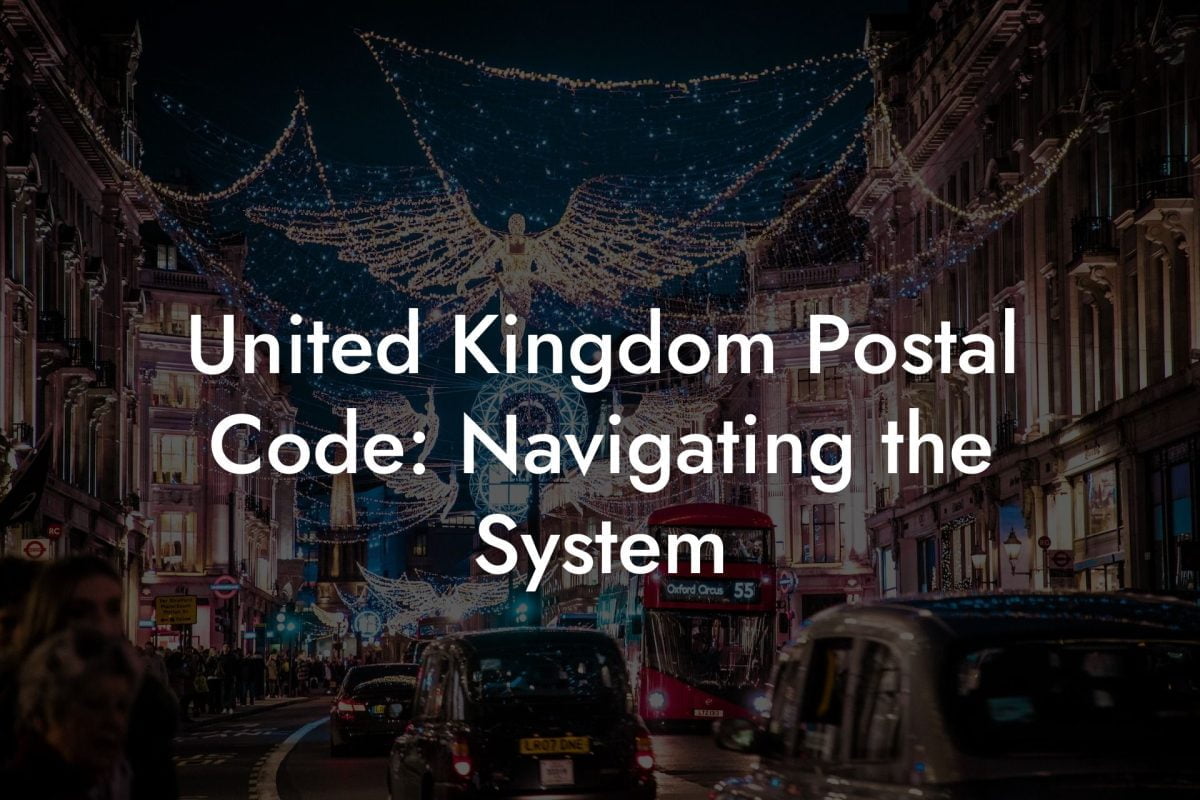The Evolution of the UK Postcode
The United Kingdom's postcode system is a triumph of organization and efficiency, integral to the country's communication and infrastructure. Its history is a fascinating journey from simple mail sorting to a critical element in today's digital and logistical frameworks. This article explores the rich tapestry of the UK postcode's history, how it revolutionized mail delivery, and its role in contemporary services.
Are you working on a Product, Service, App or Research Project that needs UK Postcode & location data? Get a free sample of our UK Postcode Database today. Find out more →
The Early Days: Concept and Implementation
Birth of the Postcode
The story of the UK postcode begins in the early 20th century. The need for a more efficient mail sorting and delivery system became apparent as London's population boomed and the volume of mail skyrocketed. The initial system, introduced in London in the 1850s, was basic, dividing the city into 10 postal districts. However, it wasn't until the 1950s and 60s that the concept of the modern postcode we recognize today was born.
Nationwide Rollout
The Norwich trial in 1959 marked the beginning of the alphanumeric system, setting the template for the codes used throughout the country. By the 1970s, the entire UK was covered, with each area receiving a unique identifier that improved sorting and delivery times significantly.
The Anatomy of a UK Postcode
Structure and Significance
Understanding the UK postcode is essential to appreciating its complexity and elegance. A standard UK postcode is divided into two parts: the outward code, which identifies the postal district or area, and the inward code, which directs to a specific address or delivery point. This systematic approach allows for incredibly precise location identification, critical for efficient mail delivery and services.
Technological Advancements and Integration
From Manual to Automated
The introduction of automated sorting machines in the 1980s marked a significant leap forward. These machines could read and sort postcodes at unprecedented speeds, dramatically improving efficiency and reducing human error. As technology advanced, the postcode became integral to various systems beyond mail, including navigation, emergency services, and marketing.
Digital Age and Data Services
In the digital era, the UK postcode has found new life as a cornerstone of data services. It's a key component in geographic information systems (GIS), online shopping, and delivery services. Its precision and ubiquity make it an invaluable tool for businesses and researchers alike.
The UK Postcode Today: A Multifaceted Tool
Beyond Mail: Diverse Applications
Today, the UK postcode is about much more than mail. It's used in planning and analysis, emergency response, healthcare services, and more. It helps businesses target customers, aids in urban planning, and ensures that services are delivered quickly and accurately.
The Cultural Impact
The UK postcode has also made its mark on culture, with postcodes becoming part of people's identity and a symbol of certain areas' social and economic status. It's a testament to the system's ubiquity and importance in everyday life.
Challenges and Innovations
Keeping Up with Change
As the UK continues to grow and evolve, so too must the postcode system. The Royal Mail continually adapts, updating and adding postcodes to accommodate new developments and changes in the landscape.
Future Prospects
The potential for integrating postcodes with new technologies, such as AI and advanced analytics, is vast. As we move further into the digital age, the role of the postcode is set to become even more central to our lives and businesses.
The UK Postcode Database: Your Gateway to Precision and Opportunity
In conclusion, the history of the UK postcode is a story of innovation, adaptation, and integration. From its humble beginnings to its status as a critical tool in numerous sectors, the postcode system has continually evolved to meet the needs of a changing nation.
At UK Postcode Database, we understand the power and potential of this system. Our comprehensive database is the perfect tool for businesses, developers, and researchers who need accurate, detailed UK location data. With our easy-to-integrate formats and one-time payment system, you gain access to a wealth of information that can enhance your services, streamline your operations, and open up new possibilities.
Whether you're planning a marketing campaign, designing a delivery route, or conducting research, the UK Postcode Database is your key to unlocking the full potential of the UK's rich geographical data. Choose precision, choose efficiency, choose the UK Postcode Database for all your products, services, and research projects. Discover the history and harness the future with us today.
Frequently Asked Questions
What Is the Origin of the UK Postcode System?
The UK postcode system originated in the early 20th century, with the first experimental postal district created in London in 1857. The modern alphanumeric system began in Norwich in 1959.
Why Was the UK Postcode System Introduced?
The system was introduced to improve the efficiency and accuracy of mail sorting and delivery, especially in rapidly growing urban areas.
How Has the UK Postcode System Evolved Over Time?
The system evolved from simple numeric London postal districts to the detailed alphanumeric codes used today, expanding to cover the entire country and becoming more precise over time.
When Did the UK Nationwide Postcode System Come Into Effect?
The nationwide rollout of the modern postcode system began in 1959 and was completed by 1974, covering all addresses in the UK.
What Were the First Areas to Use the Modern Postcode System?
Norwich was the first area to trial the modern alphanumeric postcode system in 1959, with the introduction of the 'NR' postcode.
How Did World War II Impact the Development of the Postcode System?
World War II delayed the development and implementation of an improved postcode system due to resource allocation and other pressing priorities.
What Role Did Technology Play in the Development of the Postcode System?
Advancements in sorting technology and computing significantly influenced the development and refinement of the postcode system, allowing for more complex and efficient sorting processes.
How Were Postcodes Initially Allocated to Areas?
Initial postcodes were allocated based on the operational needs and geographic layout of areas, often starting with major cities and expanding outward.
Has the Structure of UK Postcodes Changed Since Their Introduction?
The basic structure of UK postcodes (outward and inward codes) has remained consistent, but the system has expanded and adapted to accommodate new developments and changing urban landscapes.
What Were Some Challenges Faced During the Implementation of the Postcode System?
Challenges included public resistance to change, the logistical complexity of assigning codes nationwide, and integrating the system into existing postal operations.
How Did the Introduction of Postcodes Impact the General Public?
The introduction of postcodes greatly improved mail delivery efficiency and accuracy, and over time, it became an essential tool for navigation and location-based services.
Were There Any Notable Public Campaigns or Resistance to Postcodes?
Initially, some people were resistant to the change, finding the new system unnecessary or complex, but acceptance grew as the benefits became apparent.
How Has the Postcode System Influenced Business and Commerce?
The postcode system has significantly influenced business by improving delivery services, aiding in demographic and market analysis, and becoming integral to online commerce.
What Historical Events Have Been Directly Tied to Postcode Changes or Developments?
Events such as the reconstruction after World War II, urban expansion, and the rise of digital technology have all influenced postcode changes and developments.
Are Historical Postcodes Still in Use or Recognized Today?
Most historical postcodes have been replaced or updated, but some original codes, especially in older cities, remain in use.
How Does the UK's Postcode History Compare to Other Countries?
The UK was one of the early adopters of a detailed alphanumeric postcode system, influencing many other countries' systems, though the exact formats and implementation timelines vary.
What Are Some Unique or Quirky Facts About the History of UK Postcodes?
Unique facts include the intentional avoidance of potentially offensive letter combinations and the existence of non-geographic postcodes for special entities like government departments.
How Have Cultural or Social Factors Influenced the Postcode System?
Cultural and social factors have influenced the naming conventions, public acceptance, and integration of the postcode system into everyday life and business.
What's the Significance of the Postcode in Modern UK Society?
In modern society, postcodes are crucial for identity verification, navigation, delivery services, emergency response, and as a common reference in daily life.
How Can I Learn More About My Local Postcode's History?
You can learn more by visiting the Royal Mail website, local history resources, or postal museums that provide historical insights into the postcode system.
What's the Future Outlook for the UK Postcode System?
The future outlook involves continued adaptation to urban changes, potential technological integrations, and maintaining relevance in the digital age.














